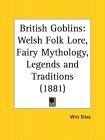Welsh Legends
|
Welsh Legends |
|
| Home | Biography | Business | Computing | Fiction | Food and Drink | Gardening | History | Learning | Psychology | Travel | Erectile Dysfunction |
| Home Prehistory History American History British History Canadian History Celtic/Welsh History Erectile Dysfunction |
|
Gelert: The Martyred HoundFrom British Goblins Welsh Folk-lore, Fairy Mythology, Legends and Traditions by Wirt Sikes (1881)Prince Llywelyn had a favourite, greyhound named Gelert that had been given him by his father-in-law, King John of England. He was as gentle as a lamb at home, but a lion in the chase, so true and so brave that he had no equal in the whole of his master's dominion. He fed only at Llywelyn's board and sentinelled Llywelyn's bed.One fine morning the Prince determined to go to the chase, and blew his horn in front of the castle. All his other hounds came to the call, but Gelert did not answer it. He blew a louder blast on his horn and shouted, "Come, Gelert, come," saying to his huntsman that it was strange that Gelert should be the last to hear his horn. But still the greyhound did not come, and the chase had to ride on without him. Llywelyn enjoyed the chase of hart and hare through the vales of Snowdon but little that day, and the booty proved scant and small because Gelert was not there. Disappointed and displeased he turned back to his castle, and as he came to the gate whom should he see but Gelert bounding out to greet him. When the hound came near him the Prince was startled to see that he was smeared all over with gore, and that his lips and fangs were dripping with blood. Llywelyn gazed at him with fierce surprise, and the greyhound crouched and licked his feet, as if surprised or afraid at the way his master received his greeting. Now, Llywelyn had a little son about two years old with whom Gelert used to play, and the thought that the hound seemed guilty of something or other made him hurry towards the child's nursery, Gelert following at his heels. Entering, he saw the floor and walls besprent with recent blood, and, worst of all, the child's cradle was overturned; the coverlet was torn and all was daubed with blood. Llywelyn called his son, but no voice replied: he searched for him, wild with terror, but nowhere could he find him. He jumped to the conclusion that Gelert had destroyed his boy, and shouting, "Hell-hound, thou hast devoured my child," the frantic father drew his sword and plunged it to the hilt in the greyhound's side, who fell with a deep groan, gazing piteously in his master's eyes. Gelert's dying groan was answered by a little child's cry from beneath the overturned cradle. There concealed beneath a tumbled heap which he had missed in his hurried search, Llywelyn found his little son unharmed and glowing from his rosy sleep. Just beside him lay the body of a great, gaunt wolf, all torn to pieces and stiff in death. Too late, Llywelyn realised what had happened while he was at the chase: Gelert had fought and slain the wolf which had come to destroy Llywelyn's heir. In vain was all Llywelyn's grief: he could not bring his faithful hound to life again. So he buried him and raised a noble tomb over his bones, repenting his rashness with many tears. He could never bear the thought of the chase after this, and hung his horn and hunting spear at Gelert's grave. To this day the place is called Bedd Gelert, or the Grave of Gelert, and if you go there you will be shown the spot where the remains of the martyred hound lie. More Welsh LegendsTales such as Why the Red Dragon is the Emblem of Wales attempt to explain the events of the post-Roman period. Later legends show Breton influence and incorporate the elements of courtly love, Arthurian tales and pageantry. Other tales incorporate fairies and the supernatural and relate them to features of the landscape. For example the legend of the 'Meddygon Myddfai' relates that a farmer in the parish of Myddfai, Carmarthenshire, having bought some lambs in a neighbouring fair, led them to graze near Llyn y Fan Fach, on the Black Mountains. Whenever he visited these lambs three beautiful damsels appeared to him from the lake, on whose shores they often made excursions. Sometimes he pursued and tried to catch them, but always failed; the enchanting nymphs ran before him ... read more about the Meddygon Myddfai legend. The Tale of Elidurus is another typical story of an earthling joining the fairy people dating from the twelfth-century. Pergrin and the Mermaiden takes contact between man and mermaid as its theme. |
 British Goblins: Welsh Folk Lore, Fairy Mythology, Legends and Traditionsby Wirt Sikes1881. In a certain sense Wales may be spoken of as the cradle of fairy legend. It is not now disputed that from the Welsh were borrowed many of the first subjects of composition in the literature of all the cultivated peoples of Europe. In the ground it covers, while this volume deals especially with Wales, and still more especially with South Wales, where there appear to have been human dwellers long before North Wales was peopled, it also includes the border counties, notably Monmouthshire. Illustrated. Contents: The Realm of Fairy; The Spirit World; Quaint Old Customs; Bells, Wells, Stones and Wagons. More information and prices from: Amazon.co.uk - British pounds Amazon.com - US dollars SeekBooks.com.au - Aus Dollars Amazon.ca - Canadian dollars Amazon.de - Euros Amazon.fr - Euros |
|
|
|
|
|
|
|
|
|
|
|
| Copyright © 1997-2006 Alan Price and HRM Guide Network contributors. All rights reserved. |